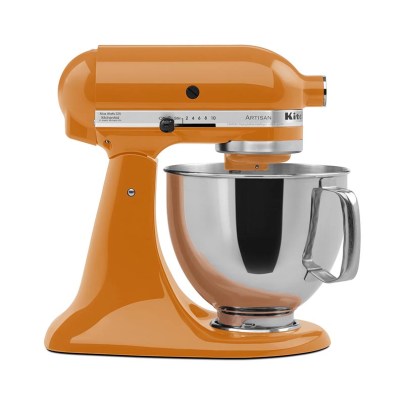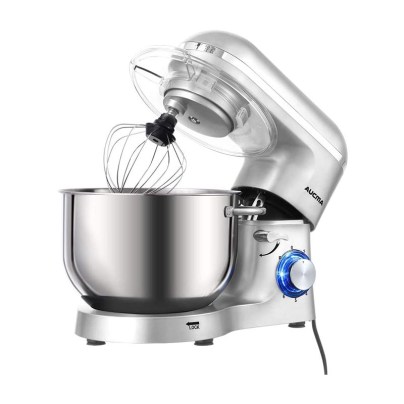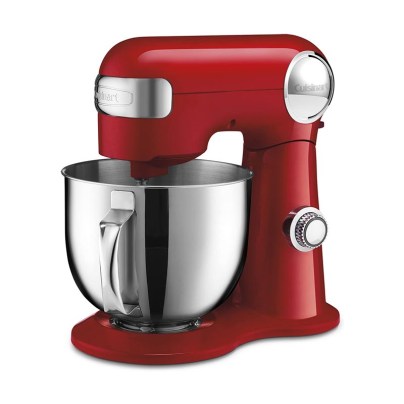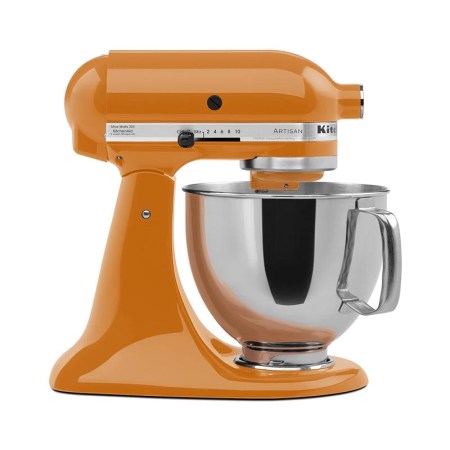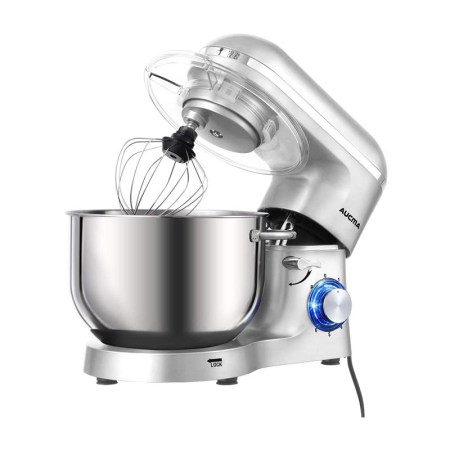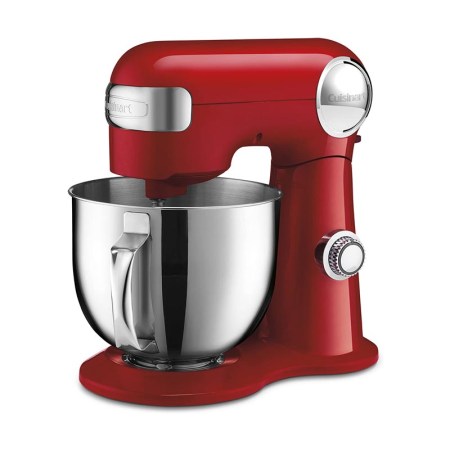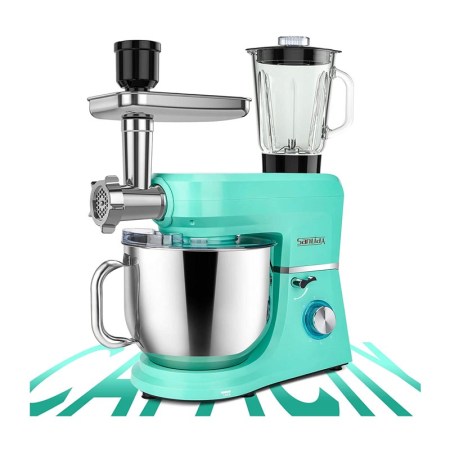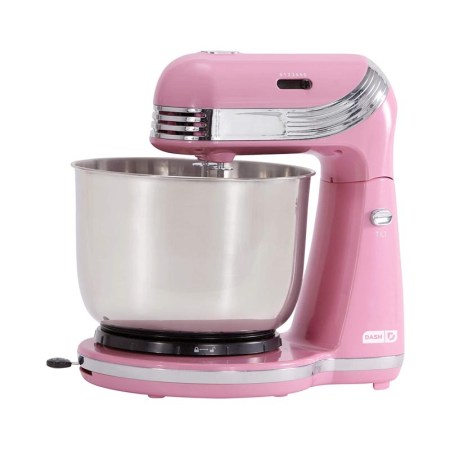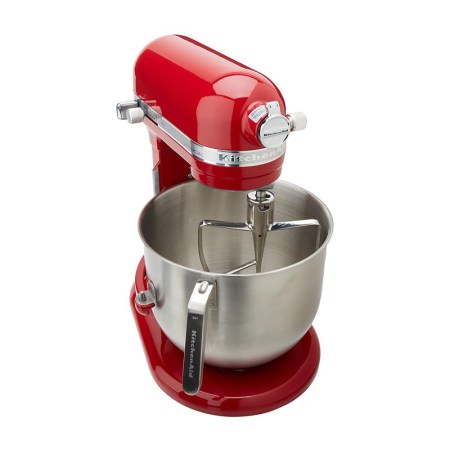We may earn revenue from the products available on this page and participate in affiliate programs. Learn More ›
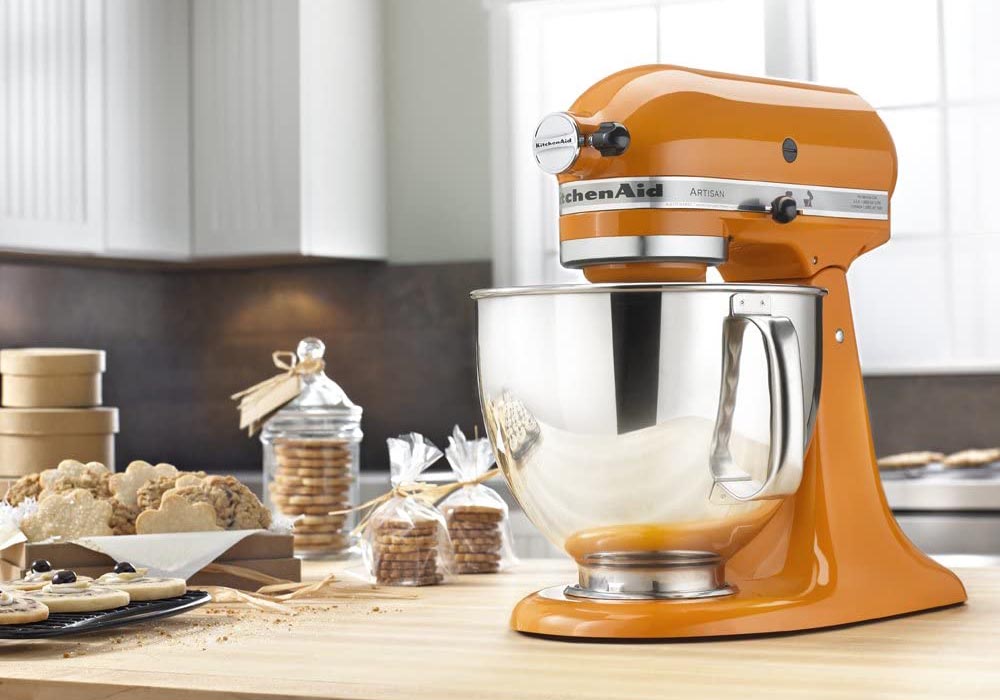
A home chef’s arsenal isn’t complete without the kitchen’s workhorse—the stand mixer. These powerful machines take the sweat out of mixing up cookie dough, bread dough, frostings, and a long list of other home favorites. The best stand mixers offer the power to mix thick doughs and reach speeds high enough to make feather-light frostings and meringues. While some models will eat up kitchen counter space, others are surprisingly compact and light.
Get ready to cook because there should be a model out there for every home cook, from the casual dabbler to the gourmet baker.
- BEST OVERALL: KitchenAid Artisan Series 5Qt. Stand Mixer
- BEST BANG FOR THE BUCK: Aucma Stand Mixer
- BEST FOR BREAD DOUGH: Cuisinart 5.5-Quart Stand Mixer
- MOST VERSATILE: SanLidA 6-IN-1 Stand Mixer
- BEST SMALL: Dash Everyday Stand Mixer
- BEST LARGE-CAPACITY: KitchenAid KSM8990NP 8-Quart Commercial Countertop Mixer
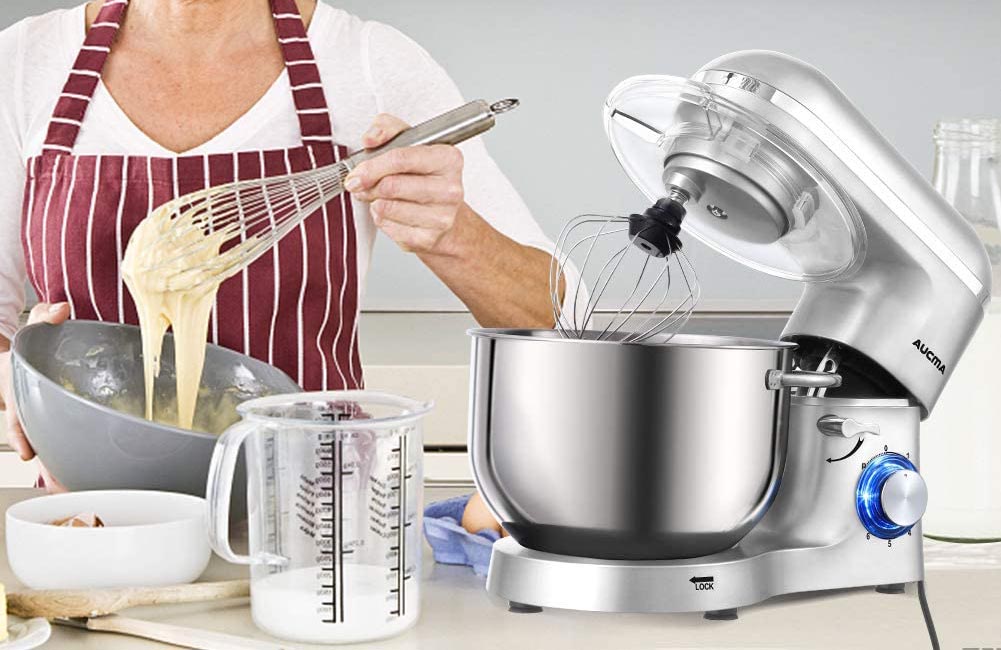
What to Consider When Choosing the Best Stand Mixer
Stand mixers can do a lot these days. Your cooking style, family size, counter space, and the types of foods you like to make can help you determine which model is right for you. Let’s go over some of the features and characteristics you’ll need to consider.
Tilt Head vs. Bowl Lift
Tilt head and bowl lift mixers each have their pros and cons. The mixing head of a tilt head model lifts backward, providing full access to the bowl and making it easier to load ingredients. These models are also shorter and smaller, so they take up less counter space. Tilt heads have some power limitations because the tilt mechanism can only take so many forces. They typically run on less than 375 watts, which is about 0.5 horsepower. Their bowls range in size from 3 to 5 quarts, so they’re generally a better option for use once a week to prepare meals for a maximum of three to five people.
Bowl lift mixers were initially designed for professionals. These models have a handle that raises and lowers the bowl to provide access to the bowl’s contents. This design makes it difficult to access and add ingredients during the mixing process. However, you can lower the bowl and add ingredients while the mixer is still running, which you can’t do with a tilt head model.
The single-piece head design of a bowl lift mixer can take greater forces than a tilt head model, with most of them running on 375 to 975 watts or about 0.5 to 1.3 horsepower. Bowl lift models are larger and heavier, but their powerful motors and heavy-duty gears can take heavy, daily use. If you use a mixer on a daily basis or cook for more than five people, this is the type of stand mixer for you.
Size and Weight
Stand mixers aren’t usually lightweight, although some of the lightest weight (and lightest duty) models weigh only 2.5 pounds. Most models weigh anywhere from 12 to 30 pounds—and that may be without the bowl or any accessories. If you store the mixer on your countertop, weight might be less of an issue. However, if you’ll need to get it out of the cupboard to use it, you’ll need the physical strength to lift and carry it.
There’s also the size to consider. Tilt head stand mixers are shorter with a narrower base because the head tilts to provide access to the bowl. Bowl lift models need extra height for the bowl lift mechanism. That also means they have a wider base for stability. Measure your available storage space, so the mixer won’t take over your kitchen.
Power
The smallest stand mixers use 250 watts. That’s enough power for periodic use, but not with thick, heavy doughs. Casual cooks will probably be happy with a mixer that takes anywhere from 300 to 375 watts. These mixers have enough power for a 3- to 5-quart bowl and can handle thick mixes as long as you’re not putting it under heavy stress every day.
Stand mixers with 375 to 975 watts are more appropriate for those who cook for large groups several times a week. You might also want this much power if you regularly mix thick bread doughs.
Bowl Size
Bowls range in size from 3.5-quart, light-use models to 10-quart, commercial models. If you have a family of two to four people, a smaller 3.5- to 5-quart bowl will probably provide enough mixing space for most of your needs. However, you may want a bigger bowl if you bake and use a stand mixer regularly, simply because many of the larger models are bowl lift designs and have higher power with faster speeds.
If you cook for five or more people on a regular basis, a 6- to 10-quart bowl provides more space and power for a higher mix volume.
Mixing Settings
Stand mixers generally have 6 to 12 speeds. The more mixing settings you have, the more versatile use you’ll get from the mixer. High speeds can whip up meringues faster than a model that tops out at six options. However, the power of the settings will also depend on the power behind them. A more powerful motor may get you more out of the mixer than extra speed settings.
Controls
The only controls many mixers have is the speed setting. That may be a dial or a knob you push forward or backward. Some models feature backlit dials, which are easier to see.
Some of the pricier models have a speed lock to prevent accidental bumping of the speed control while the mixer is in use. Others may have a slow speed start-up feature. This gradually builds speed until the mixer reaches full speed to prevent ingredients from spraying out of the bowl.
Attachments
Stand mixers are amazingly versatile and can operate as a completely different kitchen tool with the right attachment or accessory. Most stand mixers come with at least a few standard attachments, like dough hooks, scraper paddles, beaters, and whisks. Many mixers have a power hub or a built-in port for additional accessories like spiralizers, pasta makers, meat grinders, cheese graters, ice cream makers, and food processors that run using the mixer’s motor.
Since attachments can be pricey to buy separately, the more accessories the mixer comes with initially, the more money you’ll save in the long run. Multipurpose mixers can often replace many other kitchen appliances. They may not function as efficiently as an appliance dedicated to a single function, but you’ll save kitchen space.
Our Top Picks
Our top picks come from brands well known for their high-quality kitchen appliances. Power, size, bowl size, and versatility factor into these recommendations. Different models will appeal to different types of cooks with varied kitchens and cooking styles.
Best Overall
KitchenAid Artisan Series 5Qt. Stand Mixer
See ItThe KitchenAid KSM150PSBX is a sleek powerhouse. The easy-access tilt head allows you to attach and remove the bowl without removing the mixing accessory, making it easy to add ingredients or adjust recipes as you go. A 5-quart bowl offers room for most standard size recipes intended for four or five people.
KitchenAid offers over 12 additional accessories (not included with this model) for use with the front power hub, turning this mixer into a spiralizer, ice cream maker, and a whole lot more. It comes with a dough hook, six-wire whisk, flat beater, and a pouring shield. The pouring shield alone will save you time on cleanup, as it holds all your ingredients inside the bowl when mixing gets messy. It stands at 13.9 inches tall, weighs 23 pounds, and comes in 30 colors. This model offers a good blend of price, color options, and versatility to meet the demands of most home cooks.
Best Bang for the Buck
Aucma Stand Mixer
See ItThe Aucma Stand Mixer comes at a fraction of the price of some of the more well-known, name-brand mixers. However, a well-built motor that runs on 660 watts can withstand regular use, including use for thick doughs. A tilt head design provides easy access to the 6.5-quart bowl. A bowl of that size is large enough to do mixes for five or more people.
It only has six speeds, but those speeds come with a pulse function, giving you some extra options. The speed dial is backlit with an LED light that also acts as a power indicator, giving the mixer a futuristic look that complements its solid build.
Best for Bread Dough
Cuisinart 5.5-Quart Stand Mixer
See ItThe Cuisinart SM-50BC’s sleek design comes with a weight of only 17 pounds, making this a relatively lightweight mixer for the power it offers. It runs off of 500 watts and includes 12 speed settings, allowing you to use precise speed adjustments for different types of bread doughs as you expand your skills with the provided paddles and dough hook.
Cuisinart offers several additional accessories (not included with this model) to expand the use of the mixer. A meat grinder, pasta maker, and spiralizer are only a few of the options that attach to the hub. Lastly, this model comes in a few different colors to fit your personality and kitchen design.
Most Versatile
SanLidA 6-IN-1 Stand Mixer
See ItThe SanLidA brings incredible versatility to the kitchen with a six-in-one design that works with nine included accessories. Despite all of that, it only weighs 12 pounds and stands 15.5 inches high, so it takes the place of several other kitchen appliances without eating up valuable kitchen space.
A large 9.5-quart bowl holds a serious amount of batter and dough, and this machine has the power to mix that high volume. With 10 speed settings, it offers precision and speed for the variety of functions it can perform.
Best Small
Dash Everyday Stand Mixer
See ItA 3-quart bowl, tilting head, and low weight come together in a mixer that performs well above its price. This cute mixer comes in eight fun colors to make a style statement, too.
The Dash Everyday functions much like a hand mixer, mixing with either two beaters or two dough hooks, in a stand mixer design. You also get a recipe book and access to online recipes meant for the Dash Everyday’s small size. While this model isn’t meant to take heavy, daily use, it’s perfect for the small kitchen and occasional batch of cookies.
Best Large-Capacity
KitchenAid 8-Quart Commercial Countertop Mixer
See ItA whopping 8-quart bowl holds double the volume of many common recipes. To keep all those ingredients moving, a seriously powerful 1.3 horsepower motor doesn’t slow down for the thickest of doughs. For bakers who want something that can withstand heavy daily use, this mixer contains PowerCore technology to keep power steady without building heat. That lets you use it longer, even at the highest speeds. It’s also NSF certified for commercial use.
The bowl lift design supports the higher power motor. It’s fitted with commercial-grade accessories, including a whisk, paddle, and dough hook. This pro model includes two high-end features you don’t see very often: speed control protection, which prevents accidental speed changes when wiping the mixer or adding more ingredients, and a soft start feature that slowly brings the mixer to speed to reduce spills and splashing when the motor first starts running.
FAQs About Your New Stand Mixer
Stand mixers can broaden your baking and cooking horizons. Finding a model that works for your cooking style and needs can make a big difference in your satisfaction. Here are a few questions and answers to consider.
Q. How do I use a stand mixer?
A stand mixer takes the place of your arm. If you need to mix it, you can use a stand mixer to do it. They’re great for timed mixes, thick doughs, and anything that takes a long time, like whipping egg whites.
A few beginner tips:
- Start at the slowest speed, and gradually work your way up to higher speeds.
- Use the owner’s manual to determine the correct speed for different mixes and accessories.
- Make sure the bowl or tilt head is locked in place before turning on the machine.
- Use a shield to prevent ingredients from escaping when the mixer is on high speed.
Q. Is tilt head or bowl lift better?
One isn’t necessarily better than the other. They just work better for different uses. Tilt head machines are easier to manage because they’re smaller, lightweight, and make it easier to access the ingredients. You don’t have to remove the blade or mixing accessory to take off the bowl either.
However, bowl lift mixers are more powerful, meaning they can mix thicker batters for longer time periods. In general, they’re up to heavier daily use than a tilt head model. However, they’re taller, wider, and heavier, so they take up more space.
Q. Do I need a stand mixer to make cakes?
You don’t need a stand mixer to make cakes. However, you can make cakes with a stand mixer. In fact, a stand mixer will whip right through most cake recipes in half the time of hand mixing.
Q. Can I mix and knead bread dough in a stand mixer?
Almost every stand mixer comes with dough hooks designed to mix and knead bread dough. It might take some practice to get down the right mixing versus rising times, but you can definitely make delicious bread dough using a stand mixer.
